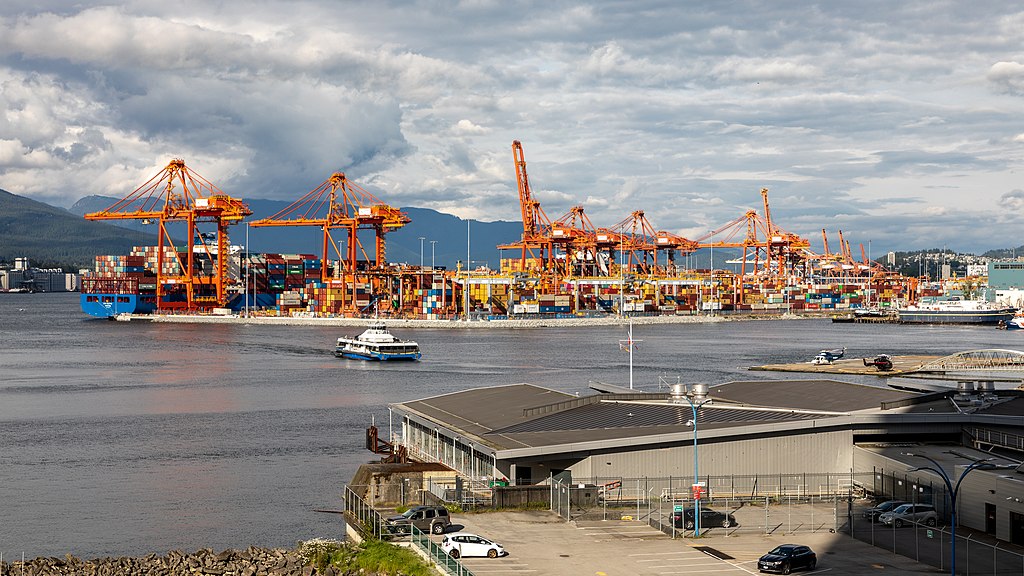By Isaac Phan Nay | The Tyee
The union for workers at the Port of Vancouver’s grain export terminals is warning that sliding safety protocols at grain silos could lead to a devastating explosion.
Tyson Compton, the recording secretary with International Longshore and Warehouse Union Local 333, says a range of causes from malfunctioning equipment to mismanaged grain can start a fire at a terminal.
Meanwhile, high volumes of grain dust — more explosive than coal dust — can escalate an ignition into an explosion.
And while companies have some safety procedures in place, Compton said the union is starting to grow concerned that safety protocols — like inspections and grain maintenance — are slipping.
“Safety measures have been lacking to the point that we’re starting to become alarmed that the likelihood of another tragedy is increasing,” Compton said.
The union says the problem could put workers and nearby residents at risk. Kingsly Ambrose, an agricultural engineering professor at Purdue University, says the union is right to be concerned but it’s not likely an explosion would damage nearby neighbourhoods.
Union leadership is calling for the federal government to strengthen safety regulations for grain workers and for more frequent inspections.
“The risk is huge,” said Jessica Isbister, ILWU Canada third vice-president. “It’s like gambling. We’re lucky it hasn’t happened yet, but when it does, it will be devastating.”
‘More powerful than coal dust explosions’
Hundreds of thousands of tonnes of grain sit within the terminals that line Burrard Inlet. The G3 Terminal, for example, can store 180,000 tonnes of grain. The Richardson International terminal in North Vancouver can store 178,000 tonnes.
Ambrose said grain silos have several characteristics that increase the risk of explosion.
Silos are enclosed spaces and contain oxygen — two necessary elements of combustion.
The silos also contain grain dust. Ambrose said at every step of the grain-handling process, from harvesting to shipping, the outer husk of wheat, barley and oat breaks down into tiny dust particles. That fine dust is highly combustible.
“Grain dust explosions are much more powerful than coal dust explosions,” Ambrose said.
Ambrose said it is possible to get rid of the grain dust by sifting it out or with air blowers, but the process is expensive and uncommon across North America.
“It’s additional effort and also reduces the profit,” Ambrose said. “Dust is money, so [silo owners] don’t want to remove it.”
The dust explodes when there is a source of ignition — anything from malfunctioning equipment to smouldering grain — and dust particles are suspended in the air, Ambrose said.
Often there are two explosions, according to Ambrose. The first, smaller explosion will scatter grain and dust into the air, which then ignites and explodes a second time.
“Secondary explosions are much more powerful than primary explosions,” Ambrose said. “If you see pictures of dust explosions, the buildings look like skeletons — it damages everything.”
While ILWU Local 333 leadership said they were concerned an explosion could damage neighbourhoods near grain terminals, Ambrose said it was highly unlikely — but not impossible — that the blast would reach homes as near as 100 metres away.
The explosion progresses until it reaches air outside the silo, Ambrose said, which can launch dust and ash into the air. He added the explosions often cause silos to collapse, which can cause damage to nearby buildings.
A worst-case-scenario explosion happened at the Port of Vancouver in October 1975. Then, a fire and explosion at the Burrard Terminal killed five workers and caused embers to rain down into the surrounding neighbourhood.
It’s been 50 years since the catastrophe — and safety practices have changed — but grain fires still occur each year in terminals across the continent.
Ambrose tracks grain dust explosions in the United States. Over the past decade, an average of 8.6 grain dust explosions have occurred each year.
Last year, there were nine grain explosions across the United States. At least two were caused by smouldering grain and another two were caused by equipment malfunction.
In Canada, 11 fire-related incidents have been reported to Employment and Social Development Canada since 2015 by federally regulated employers.
But possible causes of ignition have been reported at Metro Vancouver grain terminals nearly every year.
Five years ago, Vancouver firefighters battled a fire at the Viterra Pacific grain elevator on the city’s waterfront for nearly 40 hours before it was put out.
In 2021, one worker was injured when grain dust ignited, causing an explosion at a Vancouver port grain silo.
In 2023, air quality investigators tracked a smell to a Cargill grain terminal in North Vancouver, where the company said an overheating grain bin was emanating odours across the waterfront. According to Compton, the smell was produced by smouldering grain.
Last year, a fire broke out overnight at the G3 grain terminal in North Vancouver.
Local fire departments say they take the rise of grain fires seriously. Greg Schalk, City of North Vancouver fire department chief, said in an email the department is “aware of the operational issues in the grain industry.”
“Grain in these silos or terminals can heat up and smoulder if it is not moved, turned and cleaned regularly,” Schalk said.
He added federal laws for grain terminals require terminals to develop a safety plan that aligns with industry best practices. Then, the fire department reviews the plan and responds in the event of an emergency.
Vancouver Fire Rescue Services declined requests for comment.
When grain sits in a silo without being moved, it starts to decompose and break down, generating heat and possibly causing the grain to start smouldering — a possible source of ignition.
Even if smouldering grain does not cause an explosion, Ambrose said, it can cause fires and structural damage to silos, causing them to collapse.
“If the union sees smouldering, they should be worried,” Ambrose said. “That’s a concern.”
Ambrose said there are ways to reduce the risk of an explosion. Companies can keep air cannons on hand at silos, which can shoot carbon dioxide or liquid nitrogen onto grain and quickly extinguish fires.
Operators can also ensure silos have good airflow and regularly circulate grain.
In practice, terminals use conveyor belts to move grain around elevators, allowing it to air out and stopping the dampness that leads to decomposition and grain fires. Doug Lea-Smith, president of ILWU Local 333, calls the process “rolling over” the grain.
‘The government needs to act’
But Lea-Smith says that over the past decade terminal maintenance has slowly eroded. He tracks the decline in care to the dismantling of the Canadian Wheat Board.
For years, the Canadian Wheat Board oversaw the sale and transport of wheat, barley and oats. Established in 1935 as a marketing agency, the board eventually became the sole buyer and seller for Prairie wheat and barley exported out of the country or consumed in Canada.
The federal government did not require grain for animal consumption to move through the wheat board’s so-called “single-desk” model. Besides selling Canadian grain and distributing revenues, the board also regulated and helped co-ordinate grain deliveries to export ports.
According to Lea-Smith, as the seller of the grain, the board would keep a close eye on what happened at terminals — in part, ensuring the grain was rolled over weekly.
Terminal companies “had to maintain a certain quality of grain, and the wheat board had inspectors checking on everything,” Lea-Smith said. “That’s all gone.”
In 2012, the Stephen Harper government ended the board’s status as the sole buyer of Canadian grain and allowed farmers to sell their grain to any buyer, including the board.
Three years later, a majority stake in the board was bought by G3 Global Grain Group, a business co-owned by Saudi Arabian company SALIC Canada and U.S.-based company Bunge Canada.
“It’s changed our industry hugely,” Lea-Smith said. “The terminals have become focused on just shipping and moving the grain as fast as they can.”
Three of the companies that own the terminals — G3, Paterson Grain and Richardson International — did not respond to requests for comment. Viterra, which owns two grain terminals in Vancouver, did not provide comment in time for publication.
Sara Ragaller, a spokesperson for Cargill — which owns a grain terminal in North Vancouver — told The Tyee the Western Grain Elevator Association would be best suited to speak to the policies, procedures and best practices in place at an industry level.
The Western Grain Elevator Association did not respond to requests for comment.
Lea-Smith said that in many terminals, grain is not being rolled over as frequently.
He said occupational health and safety officers — specialists whose job it is to review health and safety hazards at job sites — don’t keep as watchful an eye on grain terminals as the wheat board once did, and only inspect terminals once a year.
“Twenty years ago, you could call an officer and they would show up if there was a problem,” Lea-Smith said. “Now we have explosions and fires and they don’t show up.”
The Canadian Grain Commission is the federal agency that oversees the quality of exported grain. Christianne Hacault, communications manager for the commission, said its inspectors are present when grain is being loaded onto ships but don’t oversee all operations at these terminals.
“If one of our employees raises a concern, then we’ll work with that company to have that resolved,” she said. “But it’s not up to us to tell private companies what to do for health and safety.”
Meanwhile, Mila Roy, spokesperson for Employment and Social Development Canada, said the agency is trying to conduct targeted inspections of grain terminals more often.
“The Labour Program at Employment and Social Development Canada takes its responsibility to protect workers seriously,” Roy said in an email.
According to Roy, the department has conducted over 140 inspections of what it calls grain industry workplaces in the last two years.
Roy said inspectors identify hazards in the workplace, provide guidance to help employers comply with the Canada Labour Code and take enforcement actions if they find non-compliance.
But Lea-Smith said that in practice, when inspectors find a hazard, they hand employers “voluntary compliance letters” that outline next steps for the company.
According to Lea-Smith, these letters rarely result in operational changes at the terminals. He said he wants inspectors to actively enforce penalties for companies who do not comply.
“Nothing happens. The inspectors need to say, ‘If I come back next week and this hazard isn’t fixed, there’s going to be a penalty,’” Lea-Smith said.
“The police don’t pull you over for speeding and give you a voluntary compliance letter.”
Lea-Smith added he is skeptical companies will take extra precautions unless nudged.
He’s calling for the federal government to step in and send occupational health and safety officers to inspect the terminals more frequently and create safety regulations specifically aimed at reducing the risk at grain terminals.
“The [terminals] are letting safety measures slide, and not only are the workers on the frontline at risk of losing their lives, but possibly community members,” Lea-Smith said. “The government needs to act.”






